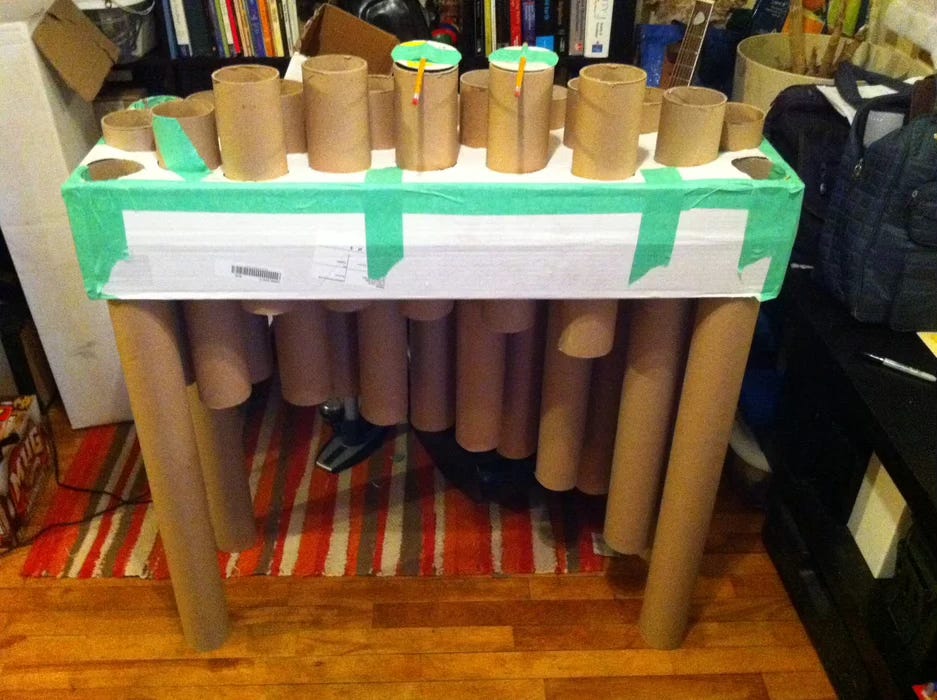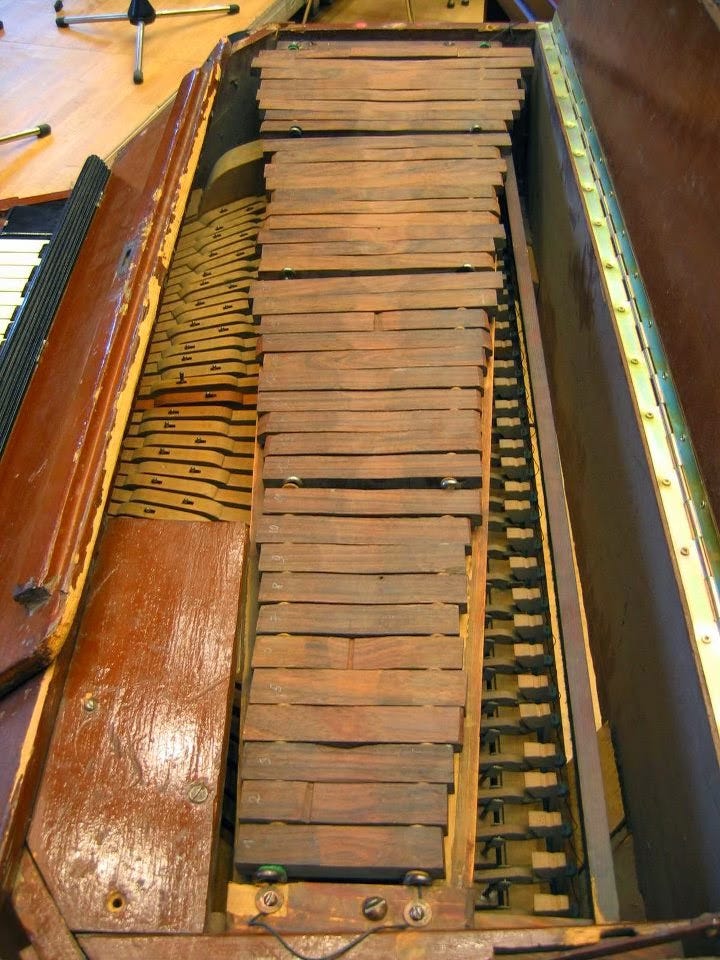Ensemble Bash's World of Percussion No. 13
Big drum battle | Bamboo boogie | Viola Smith | Keyboard clonk | Berimbau
Greetings! Welcome to the 13th edition of this, our monthly meander through the marvellous macrocosm of matters mallet and musical.
Of course, given the alliteration in our titles - Big drum battle, bamboo boogie and berimbau, it was tempting to push all the way for an across the board set of Bs, but what for Viola Smith, that extraordinary and inspiring woman?
Bashing band boss? Blistering beat brilliance?
Leave it. When you get there, enjoy one of the most joyous and spirited drummers of all time.
Meanwhile, we promised you a big drum battle.
Unless you come from Northern Ireland, this will probably be new to you.
Enjoy. And marvel.
WoP#1
As far as we know, there’s nothing like this anywhere else in the world.
(Of course, if you know better, please leave a comment - we’d love to hear about it!)
The lambeg is a drum found only in Northern Ireland and apparently, is one of the two loudest instruments in the world (the bagpipes being the other).
Just under a metre in diameter, and just over half a metre deep, this big baby weighs about 18kg (about 40lbs) and is whipped fast and furiously with a slightly bendy malacca cane on each side.
Originally it was part of a fife and drum combo, but the increasing size of the drums and the skill of the players meant that the fife became drowned out, and now they’re rarely found together.
While it’s association with the marching season and the Orange Order give it a nationalistic connotation, it’s still possible simply to marvel at the extraordinary intensity of it all.
Watching this 1964 report of a drum battle is to be dropped into a different world.
What appears to be a pointless act of ‘my drum’s louder than yours’ turns into a healthy, friendly, muscular and rhythmic competition in which mutual respect and rivalry appears to be the order of the day.
At about 5 minutes into this video, the combatants stop for a breather… at this point they’ve been playing for over an hour, and the interviewer asks who’s winning.
It’s a lovely moment, and the break lasts for less than a minute before they’re off again - and presumably the crowd having been standing there the whole time, too.
Extraordinary.
“The funny thing is, you know, that when you first arrive here, and you hear this row, it sounds like the most awful noise on earth. But after a little while, it gets in the blood…”
The final scene, from about 6’30”, as the lone drummer walks into the distance of a misty, grimy urban landscape, is simultaneously poignant, life-affirming and heart-breaking, evoking a world long gone.
The stick technique is extraordinary. We have no idea what they’re doing.
If you do, let us know!
If that’s whetted your appetite, we can fast forward 24 years to the wonderful Frank Orr, lambeg drummer on his way back to Lambeg (did we mention it’s actually a town?) for a competition.
This is fascinating.
A slow-motion, unhurried exploration of a community engrossed in one simple activity. Just watching the lambeg manufacturer applying his secret formula oil to the skins is to see a man deeply in love with his calling.
They don’t make’em like that any more.
WoP#2
That’s quite enough nostalgia.
Time for something brighter and boppier.
The Final Countdown. Yes, the 1986 song by Europe, all big hair and screaming, but played on an instrument from Papua New Guinea.
We’ve been unable to track down the Papuan name of this instrument, but elsewhere it’s known as a thongophone, on account of the bamboo being hit by thongs (flip flops for those in the UK).
Again, if you know what it’s really called, let us know!
Have a bit of traditional groove. The energy is infectious and they just look like they’re having the best time ever.
Goodness knows what that playing position does for your back, though…
This instrument was developed and turned into a theatrical spectacle by the Blue Man Group (who also call it a drumbone).
Here they are, having fun with blue paint and tequila.
The Blue Man Group performances on YouTube are a fine rabbit-hole to lose yourself down, should you ever have an afternoon to spare…
The legendary drummer and composer Stewart Copeland once compared Ensemble Bash to the Blue Man Group, which we never quite understood…
And if you want to get yourself into that bonging groove, here’s how to make your very own thongophone (here called a slap-o-fone) with just some cardboard rolls and sticky-back plastic.
WoP#3
Last month we featured the extraordinary Limpe Fuchs, and this month for our featured drummer, we’re going back a little further, to Viola Smith.
Born 2 years before the First World War, she was still drumming when Covid-19 closed down most of the planet, passing away at the age of 107.
She was one of the first professional female drummers, and had a unique signature kit with two low tom toms hung behind her, over her shoulders, giving her playing an energetic flamboyance that even now is an absolute joy to watch.
“You see, when you have a drum up here and a drum up there, it looks like showmanship… and I have no problem with showmanship”
A lot of her work was with all-female bands, but she became a star in her own right, eventually leading her own band.
In 1942 she wrote an article for Down Beat magazine, arguing that,
“In these times of national emergency, many of the star instrumentalists of the big name bands are being drafted. Instead of replacing them with what may be mediocre talent, why not let some of the great girl musicians of the country take their place?”
Here’s a detailed and fascinating analysis of Viola’s drumming. It’s clearly a labour of love, transcribing many of her fills and grooves, and demonstrating just how talented she really was.
A splendid use of 12 minutes of your time, featuring some delightful interviews with the woman herself.
Incidentally, Viola Smith and Chris from Ensemble Bash have one thing in common - they both started on piano.
Viola moved to drums because her father wanted to start an all-female band from his 7 daughters and being sixth in line, all the other instruments she wanted to play were gone - so she became a drummer by accident.
Chris became a drummer because the school he was in needed a percussionist for their orchestra, and the head of music told him…
“You can read music, and percussion’s easy. All you do is hit it”
How right he was.
Sometimes.
WoP#4
Percussion both suffers and thrives on the sometimes insane ideas that people have for an instrument.
Can you hit it? It’s an instrument. John Hardy’s Ars Malleo Caedendi (the Art of Hammering) featured 127 instruments, which included the spinning drum from a washing machine and one from a tumble dryer. Both sounded remarkably similar and unsurprisingly clanky, while George Antheil’s Ballet Mécanique features the propellor from an aeroplane.
(Incidentally, Antheil’s other claim to fame was that, along with actress Hedy Lamarr, he invented a radio guidance system for torpedoes in the second world war that used spread spectrum and frequency hopping technology, which came to be the basis of wifi, GPS and Bluetooth)
But then every so often, someone takes a perfectly reasonable instrument and decides that it needs an upgrade.
Such a someone it was, who thought that the only way to improve on a xylophone was to attach it to a piano keyboard.
This rather dubious notion was compounded by the great Béla Bartók who thought it would be a capital notion to write a formidable two hand part for his opera Bluebeard’s Castle.
Here, thanks to David Valdès’s wonderful blog Percusize Me! (highly recommended if you fancy a long and fascinating rabbit hole of an evening) is - it’s claimed - that actual instrument that Bartók would have written for.
David goes on to discuss the history in depth here, but of course if a modern orchestra wants to play that piece, how do they get round it?
Trying to play it with two players would cause huge synchronisation issues, so the solution?
Build another, single-use only instrument.
Of course.
And here, with the Royal Concertgebouw Orchestra, is the extract in context. This is a nicer-sounding instrument, made by Adams Percussion.
(The audio and video on that clip are not precisely aligned, so if you’re on Facebook, this is a better recording https://fb.watch/Cujb3fPTeu/)
WoP#5
What we’re listening to
Ensemble Bash once had the honour and privilege of collaborating with legendary Brazilian percussionist Naná Vasconcelos shortly before his death.
Though he played a myriad instruments exquisitely, he specialised in the berimbau, a single string bow, played with…
Oh never mind the description, just watch him play.
Hypnotic, ethereal, trance-like music that draws hundreds of colours from the most unprepossessing of instruments.
Unlike the keyboard xylophone, which goes clunk.
Quite, quite beautiful.
Bonus WoP
Ensemble Bash got themselves together in a rehearsal room and armed with a few phone cameras and minimal recording equipment, put together this - we think - lovely video of Michael Blake’s 1996 arrangement of his 1986 composition of Let Us Run Out of the Rain.
The piece itself was written for either two pianos or two harpsichords, but the writing, based on kalimba (thumb piano) music from Zambia, lies happily and comfortably in the sound world of vibraphone and marimba.
Eight minutes of calm, meditative beauty.
Please enjoy.
Follow us on Facebook here or on Instagram here.





